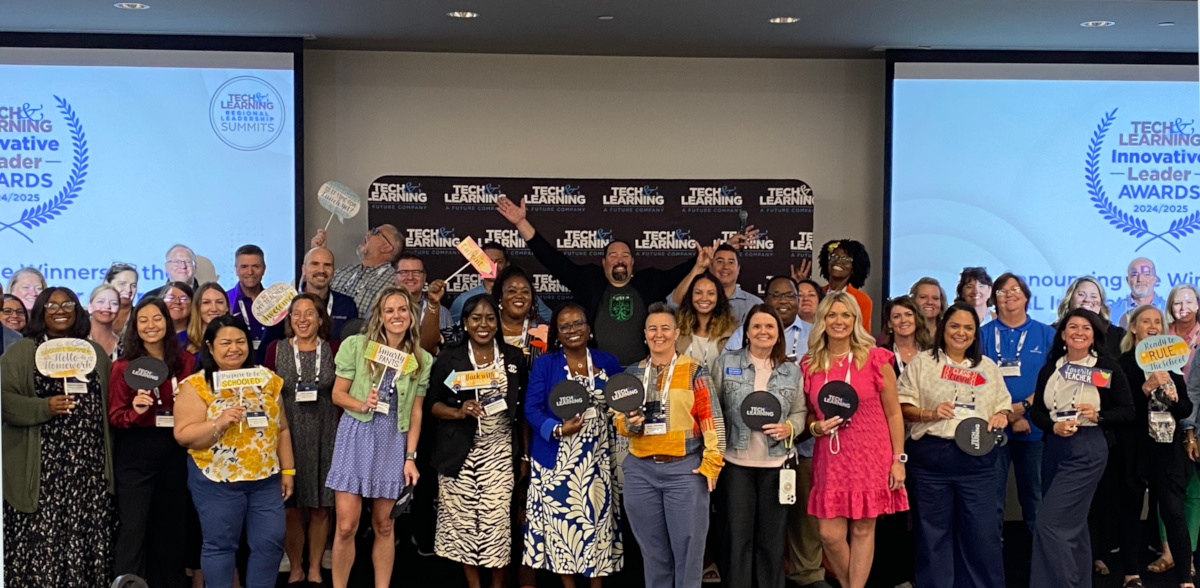Executive Briefing
The latest edtech news curated by Tech & Learning Leader editor Annie Galvin Teich.

1 Cybersecurity Is the Top Priority for District IT Leaders
The just-released 2019 K–12 IT Leadership Survey from CoSN cites cybersecurity as the number-one challenge for district IT professionals. The top three challenges faced by IT leaders for the past three years remain the same: budget, professional development, and breaking down department silos. BYOD continues to decline in popularity, with only 16% of school districts reporting they still use the strategy. Virtually all IT leaders (95%) list the homework gap as a concern for their district. Surprisingly, print is not dead. Sixty-seven percent of districts report that print still comprises at least half of their instructional materials. While there has been some progress in areas of interoperability, Single Sign-On (SSO) has only been implemented in just over a quarter of districts. Most IT leaders have education backgrounds (40%), followed by technical backgrounds (35%), and there is a growing number from business/management backgrounds (20%). Lack of ethnic and racial diversity in district IT leadership remains a serious problem, with no progress since last year. Rounding out the top 10 survey findings is the fact that the percentage of women in school IT leadership roles has declined in recent years.
2 New Jersey’s County-Run Career and Technical High Schools Prepare Students for the Future
The Hechinger Report describes New Jersey’s 66 county-run career and technical schools (CTEs) that integrate work-based training with rigorous academic coursework to prepare students for both college and careers. New Jersey, like other states, is facing a shortage of skilled workers in fields such as manufacturing, logistics and distribution, transportation, and healthcare. Graduation at the CTE high schools tops 97%—compared to 91% statewide—and more than three-quarters of graduates continue on to college or post-secondary education. Passaic County Technical Institute is a public high school that offers work-based learning programs in fields ranging from business and applied technology to construction and cosmetology. Students spend mornings in the classroom and afternoons working. These types of programs are intended to prepare young adults for the labor market of the future for positions that require both technical skills and some college education. This model is notable because the schools are run by county governments and not school districts. Close relationships with county leadership give schools direct connection to local businesses.
3 Tech Integration Comes Alive through Coaching
Emily L. Davis and Brad Currie report in ASCD Express that the research is clear that coaching is critical to the success of tech integration. The authors outline six critical factors to ensure tech coaching programs are effective:
Good coaches are developed, not born. They must understand the school’s goals and have the frameworks, language, and tools to create meaningful learning for others.
Tools and ideas to transform education. Sign up below.
Pedagogy must come first. Technology integration frameworks like TPACK and SAMR are helpful in thinking about the appropriate place of technology in instruction.
Coaching can be more than one-on-one support. Coaches need to facilitate professional learning in groups. Setting benchmark goals for integration and metrics for success are critical for remaining focused on common goals.
Tech coaches, and everyone else, must understand their role and value. When all stakeholders, including coaches, are clear about how coaching supports improved teaching and learning, the work solidifies around a common vision.
There must be a plan for continuous improvement and sustainability. Implementation data focuses on the quality of the coaching. Impact data focuses on the ways in which the work influences teacher and student practice.
Continual learning is key. Coaches need to create goals and action plans that ensure they continue to grow both their technological and coaching expertise.
4 Drones Take Their Place in the K–12 Classroom
These small aircraft advance learning in computer programming and photography and prep students for careers in this burgeoning field. As reported by EdTech Focus on K–12, teachers Ray Sevits and David Steele have been certified as drone pilots by the FAA and now teach drone technology in Colorado Springs (CO) School District 11. Sevits’s middle-school students master the art of flying drones as they learn the conceptual physics of how the aircraft work and how to fix them when they crash or break. Steele teaches the same concepts to high-school students as they design and build their own drones and prepare to earn FAA certification as drone pilots. Steele is developing a comprehensive two-year, four-semester drone program. Students will learn to fly, design, and build their own drones the first year. Then they will learn about photography, videography, and surveying land using geographic information system technology.
5 Schools Use Texts and Apps to Communicate with Families
Whether it’s TalkingPoints, an app that translates text messages into a parent’s home language; Possip, a text-message-based system that allows parents to text feedback to teachers and schools; or ClassDojo, which allows direct messaging within an app to connect parents to the inside of their child’s classroom, the concept of direct messaging between school and home is gaining traction. Texting is simple and intuitive technology to implement, but for many schools, the challenge is not technological but a mindset that parent engagement isn’t important or valuable. Family engagement must be a priority for it to be successful. Relying on a phone number for communication can prove difficult in low-income areas where phones are disconnected or phone numbers change frequently. An alternative is WhatsApp, a messaging service that works like text messaging but doesn’t rely on a specific phone number. Talking to families through texting allows them to quickly identify the sender and the message, so texting can be less invasive and burdensome than a phone call.
6 The Digital Equity Act of 2019
Led by Senator Patty Murray and other Senate Democrats, the Digital Equity Act of 2019 has been endorsed by many educational associations, such as SETDA, CoSN, and the ALA, and is intended to close the digital divide in communities throughout the country. The Digital Equity Act builds on recent efforts to increase access to broadband by prioritizing “digital inclusion”—activities that seek to provide individuals and communities with the skills, supports, and technologies necessary to take full advantage of a broadband internet connection when they have one. Legislation creates two new $125M grant programs aimed at promoting #DigitalEquityNow and supporting digital inclusion programs for students, families, and workers. Read more about the Digital Equity Act of 2019 at https://tinyurl.com/DigitalEquityAct2019.
